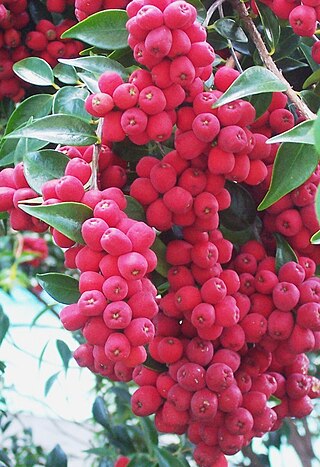
Syzygium luehmannii is a medium-sized coastal rainforest tree native to Australia. Common names include riberry, small leaved lilly pilly, cherry satinash, cherry alder, or clove lilli pilli.
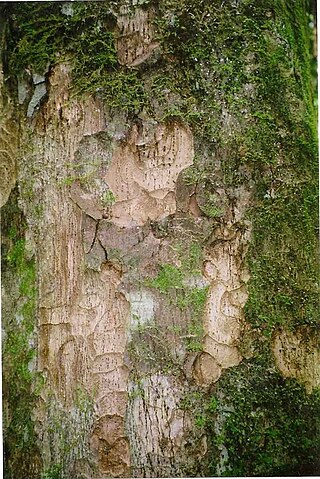
Litsea reticulata is a common Australian tree, growing from near Milton, New South Wales to the Bunya Mountains, Queensland. Common names include bollygum, bolly wood and brown beech. The habitat of the bollygum is rainforest of most types, except the dryer forms.

Ehretia acuminata is a deciduous tree found in Japan, China, Bhutan, Nepal, Laos, Vietnam, New Guinea and Australia. Fossil evidence suggests an ancient Laurasian origin. This group of plants spread to Australia and South America via Africa, when these continents were still joined.

Endiandra sieberi, known as the corkwood is a rainforest tree growing in eastern Australia.

Stenocarpus salignus, known as the scrub beefwood is an Australian rainforest tree in the family Proteaceae. Found in warmer rainforests on the coast and ranges. It is often found in warm temperate rainforest on poorer sedimentary soils, or on volcanic soils above 750 metres above sea level. It was originally described by the botanist Robert Brown in 1810.
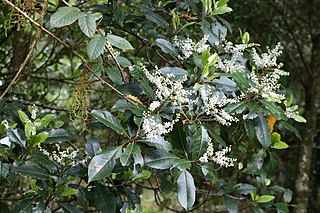
Quintinia sieberi, known as possumwood, is a rainforest tree of eastern Australia. It is mostly found in rainforests at high altitude. The range of natural distribution is between the Clyde River, New South Wales and the McPherson Range just over the border in the state of Queensland.

Rhodosphaera is a genus of plants in the family Anacardiaceae. The genus includes a single species, Rhodosphaera rhodanthema, which is a rainforest tree of eastern Australia. It grows in sub tropical rainforests and also in the drier form of rainforests. The natural range of distribution is from the Macleay River, New South Wales to Maryborough in south east Queensland. Common names include deep yellowwood, yellow cedar and tulip satinwood.

Cryptocarya laevigata, known as the glossy laurel or red-fruited laurel, is a rainforest plant, which ranges from Malesia and New Guinea to eastern Australia. In Australia it grows in the rainforest understorey on fertile soils, from the Richmond River, New South Wales to Cairns in tropical Queensland, where it is often seen in association with the White Booyong.

Cryptocarya foveolata, known as the mountain walnut is a rainforest tree growing at high altitude in eastern Australia. Despite the common name, it belongs to the laurel family.

Maytenus silvestris is a shrub or small tree growing from Picton, New South Wales near Kroombit Tops, near Gladstone, Queensland. It occurs in dry rainforest, eucalyptus and rainforest ecotone areas. Common names include narrow leaved orangebark, orange bush and orange bark.

Elattostachys nervosa, known as the green tamarind or beetroot tree is a common rainforest tree of eastern Australia. Found in all types of rainforest, growing from Paterson, New South Wales in the south to Gympie in south east Queensland. The name Elattostachys refers to "little spikes", a flower feature of other plants in this genus. Nervosa refers to the prominent leaf venation. Beetroot Tree refers to the beetroot red leaves of the new growth.
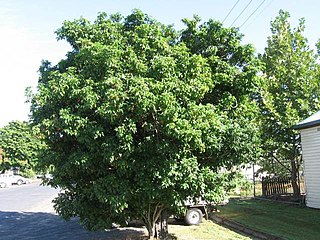
Harpullia pendula, known as the tulipwood or tulip lancewood is a small to medium-sized rainforest tree from Australia. The tree's small size, pleasant form and attractive fruit ensures the popularity of this ornamental tree. The range of natural distribution is from the Bellinger River in northern New South Wales to Coen in tropical Queensland. Tulipwood occurs in various types of rainforest, by streams or dry rainforests on basaltic or alluvial soils. In tropical and sub tropical rainforest. Often seen as a street tree, such as at St Ives, New South Wales.

Mallotus philippensis is a plant in the spurge family. It is known as the kamala tree or red kamala or kumkum tree, due to the fruit covering, which produces a red dye. However, it must be distinguished from kamala meaning "lotus" in many Indian languages, an unrelated plant, flower, and sometimes metonymic spiritual or artistic concept. Mallotus philippensis has many other local names. This kamala often appears in rainforest margins. Or in disturbed areas free from fire, in moderate to high rainfall areas.

Niemeyera whitei known as the rusty plum or plum boxwood is a rare tree of eastern Australia. It occurs on poorer soils in areas below 600 metres above sea level. Found in gully, warm temperate or littoral rainforests. From the Macleay River, New South Wales to Tallebudgera Creek in south eastern Queensland.
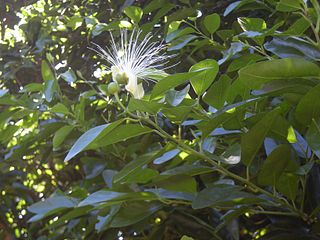
Capparis arborea is a bush or small tree occurring in eastern Australia. The habitat is rainforest; usually riverine, littoral or the drier rainforests. Distributed from the Hunter River, New South Wales to Cape Melville in tropical Queensland. Common names include native pomegranate, wild lime, wild lemon and brush caper berry.

Rhodamnia argentea is a rainforest tree of eastern Australia. Commonly known asmalletwood, white myrtle, silver leaf, silver malletwood and white turpentine. The natural habitat is a variety of different rain forests, at sea level or in the adjacent ranges. Growing on sand, alluvium and volcanic based soils. From the Hastings River, New South Wales to Bowen, Queensland.
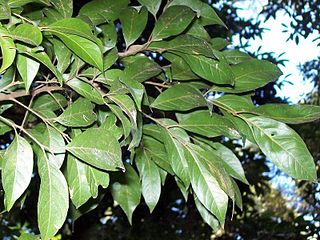
Sarcopteryx stipata, known as the steelwood, is a rainforest tree of eastern Australia occurring from the Bulga Plateau and Comboyne Plateau north west of Taree, New South Wales as far north as Fraser Island off the coast of south eastern Queensland. It grows in sub tropical rainforest but sometimes occurs in warm temperate rainforests on poorer soils. It is a member of the soap berry family. The generic name Sarcopteryx translates to "fleshy wing", as the fruit can be wing shaped. Stipata means "surrounded". The common name steelwood refers to the very tough, hard and heavy timber.

Mischocarpus pyriformis, known as the pear fruited tamarind is a rainforest tree of eastern Australia. Occurring from Seal Rocks, New South Wales to as far north as Cooktown in tropical Queensland. The sub species found in New South Wales is Mischocarpus pyriformis subsp. pyriformis.

Endiandra introrsa is a rare rainforest tree growing in eastern Australia. Listed with a Rare or Threatened Australian Plants (ROTAP) rating of 3RCa. Its habitat is warm temperate rainforest on the poorer rainforest soils, mostly over 300 metres in altitude, and its range of natural distribution is from near Dorrigo to various sites in the state of Queensland.

Petalostigma triloculare, known as the long-leaved bitter bark is a rainforest tree of eastern Australia. It occurs in the drier rainforests, often on sandy soil derived from granite or sandstone, and is sometimes seen on old sand dunes.






















